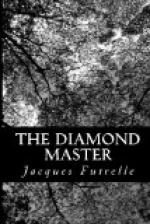“The violence of the operation, coupled with the intense heat, fuses everything—furnace, projectiles, electric wires, fire-brick, even asbestos, into a single mass. The cube is opened, and this mass, white-hot, is dropped into cold water. This increases the pressure until the mass is cool. Then it is broken away, and in the center is a diamond—as big as a biscuit, gentlemen! Four small bores lead from the two-inch bore through the cube, and permit the escape of air as the projectiles enter. There is no rebound because the elastic quality of the carbon is crushed out of existence—driven, I may say, into the diamond itself. Of course the furnace, the two projectiles and the connecting electric wires are all destroyed at each charge, which brings the total cost of the operation to a little more than eight hundred dollars, including nearly three tons of brown sugar. The diamond resulting is worth at least a million when broken up for cutting, sometimes even two millions. That is all, I think.”
There was a long, awed silence. Mr. Latham, leaning against the giant cube, stared thoughtfully at his toes; Mr. Schultze was peering curiously about him, thence off into the gloom; Mr. Czenki still had a question.
“I understand that all the diamonds were made in that disk-like shape,” he remarked at last. “Then the uncut stones that were stolen were—”
“They were natural stones,” interrupted Mr. Wynne, “imported for purposes of study and experiment. I told Chief Arkwright the truth, but not all of it. In the last twenty years Mr. Kellner had destroyed some twenty thousand dollars’ worth of diamonds in this way. I may add that while Mr. Kellner had succeeded in making diamonds of large size he had never made a perfect one until eight years ago. But meanwhile the expenses of the work, as you will understand, were enormous, so during the past eight years about a million dollars’ worth of diamonds have been sold, one or two at a time, to meet this expense.”
He paused a moment, then resumed musingly:
“All this, you understand, is not the work of a day Mr. Kellner was nearly eighty-one years old, and it was fifty-eight years ago that he began work here. The cubes there were made and placed in position thirty years ago; the guns have been there for twenty-eight years— so long, in fact, that recollection of them has passed from the minds of the men who made them. And, until four years ago, he was assisted by his son, Miss Kellner’s father, and her brother. There was some explosion in this chamber where we stand which killed them both, and since then he has worked alone. His son—Miss Kellner’s father—was the inventor of the machine which has enabled us to cut all the stones I showed you. I mailed the application for patent on this machine to Washington three days ago. It is as intricate as a linotype and delicate as a chronometer, but it does the work of fifty expert hand-cutters. Until patent papers are granted I must ask that I be allowed to protect that.”




